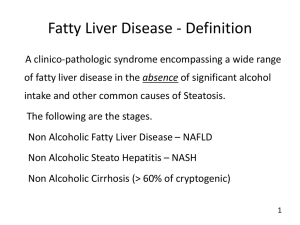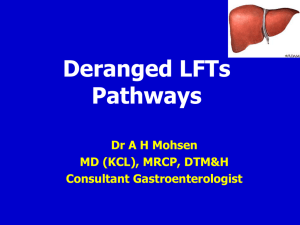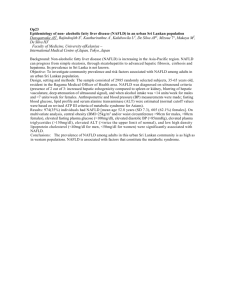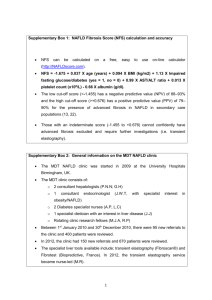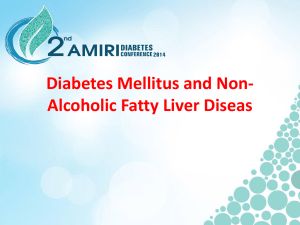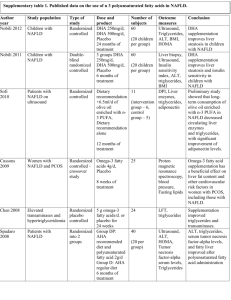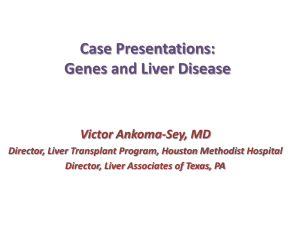NAFLD Non-alcoholic fatty liver disease
advertisement
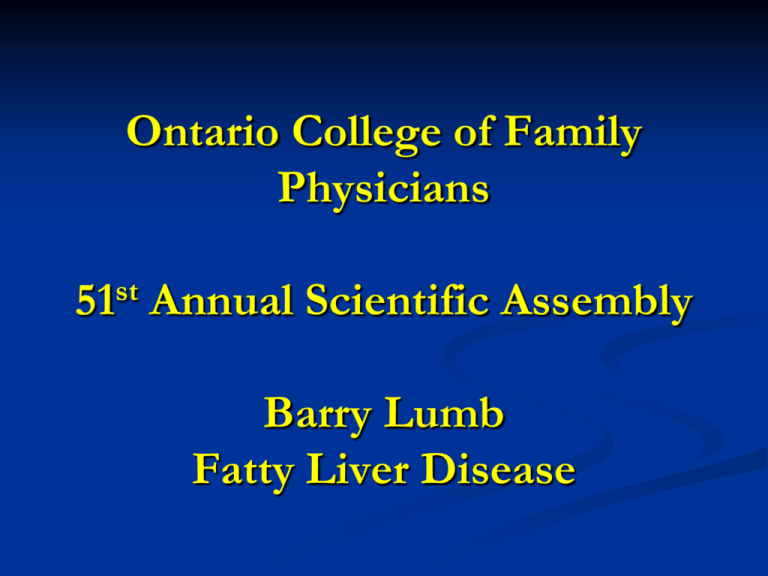
Ontario College of Family Physicians 51st Annual Scientific Assembly Barry Lumb Fatty Liver Disease Faculty/Presenter Disclosure • Faculty: Dr. Barry Lumb • Program: 51st Annual Scientific Assembly • Relationships with commercial interests: – NONE Disclosure of Commercial Support • This program has received NO financial support in any form • This program has received NO in-kind support from any organization • Potential for conflict(s) of interest: NONE Mitigating Potential Bias • NONE NAFLD: Non-alcoholic fatty liver disease Definitions Epidemiology Pathogenesis Diagnosis Interpretation of liver biochemistry Prognosis Management options NAFLD: Non-alcoholic liver disease NAFL: Simple fat accumulation, no inflammation or fibrosis NASH: Fat accumulation with varying degrees of inflammation and/or fibrosis NASH cirrhosis NAFLD Most common liver disorder Majority of previously diagnosed “cryptogenic cirrhosis” Very high prevalence depending on modality used: Ultrasound – >15% MRI - >30% Liver biopsy – 33% potential donors Autopsy – 70% of obese, 35% of lean patients NASH and cirrhosis in much smaller percent NASH “Metabolic steatohepatitis” Histologically indistinguishable from alcohol induced liver disease Various grading systems Degree of inflammation Degree of fibrosis (ie. Risk of cirrhosis) NAFLD: Non-alcoholic fatty liver disease NAFL: Non-alcoholic fatty liver NASH: Non-alcoholic steatohepatitis NAFL NASH “Significant alcohol intake” Amounts are unclear Balance between potential for liver disease versus probable protective effect of moderate alcohol Probable higher risk in obesity, female, NAFLD Male – 2 drinks per day Female – maybe < 1 drink per day NAFLD Predictors – ? Female gender Obesity Diabetes Age > 40 Metabolic syndrome Obstructive sleep apnea Hyperuricemia Polycystic ovary syndrome Hyperlipidemia (esp hypertriglyceridemia, low HDL Ethnic variability (Hispanic origin) Metabolic Syndrome Most predictive of NAFLD and NASH Central obesity - BMI or W/H ratio Arterial hypertension Dyslipidemia (↑TG or ↓HDL) Glucose intolerance/insulin resistance NAFLD Obesity and other risk factors are not universal Rule out other secondary causes of fatty liver Meds – amiodarone, methotrexate, tamoxifen, steroids Other rare conditions – Wilson’s, Starvation, Hepatitis C genotype 3, TPN Pathogenesis: “Two hit” hypothesis First Hit Insulin resistance causes hyperinsulinemia Promotes FFA generation from adipose tissue Promotes de novo hepatic lipogenesis May activate profibrotic cytokines Impaired balance between influx, synthesis of hepatic lipids versus export or oxidation Hepatic triglyceride accumulation in the liver (steatosis) Reduced hepatic export of VLDL Pathogenesis: “Two hit” hypothesis Second hit Steatotic liver vulnerable to secondary injury Inflammation Fibrosis Cirrhosis Pathogenesis: “Two hit” hypothesis Second Hit Other mediators/factors cause oxidative injury Low anti-oxidant levels Iron excess Leptins – stimulate platelet derived growth factor Abnormal gut microbiome Adiponectin – normally protective, reduced in NAFLD NAFLD - Diagnosis Usually asymptomatic – vague, non-specific symptoms Incidental finding Hepatomegaly Liver chemistry testing Ultrasound, CT, MRI Screening in high risk individuals NAFLD: Liver Biochemistry Mild to moderate ALT elevation AST/ALT ratio <1 (unless cirrhotic) Versus alcohol >2 Very poor correlation between severity and ALT levels Possibly: ↑ferritin, IgA, GGT SMA, ANA positive Hepatocellular enzymes: AST, ALT Sensitive indicators of hepatocellular damage AST many sources ALT serum half life > AST Hepatocellular damage ALT elevation predominant AST:ALT ratio <1 Hepatocellular enzymes: AST, ALT ? Extent of investigation of ALT < 3 x normal < 6 months duration Rule out Hepatitis B and C Elevated Ferritin, Iron saturation >45 Drugs Ultrasound NAFLD highly probable NAFLD: GGT Sensitive but non-specific indicator of biliary disease Clarification of source of raised AP Induced by ethanol, phenytoin and other drugs Strong association with BMI, NAFLD, alcohol, cholesterol, triglycerides, analgesic usage Alcohol and liver enzymes Prolonged intake Depletion of hepatic AST and ALT but ALT predominant AST/ALT ratio > 2 Total AST < 400 Frequently striking elevation of GGT NAFL or NASH? Significant red flags Clinical stigmata of chronic liver disease Spiders Splenomegaly Elevated MCV Elevated ferritin Low platlets (<140,000) Imaging – “shrunken liver”, splenomegaly, ascites NAFLD: ALT level Poor association between ALT level and degree of fatty infiltration, inflammation and fibrosis Don’t let a low ALT talk you out of concern if other features present NAFLD: Imaging Ultrasound, CT, MRI Reliable for moderate to severe fatty infiltration No association with NAFLD versus NASH, fibrosis Associated features of cirrhosis Fibroscan is promising for assessing degree of fibrosis NAFLD: Assessing severity Independent markers of progression to fibrosis Age > 50 (OR 14.1) DM (OR 12.5) – especially poorly controlled BMI > 28 (OR 5.7) Triglycerides >1.7 (OR 5) Other markers of inflammation and fibrosis? IgA, hyaluronic acid levels Risk factors – DM, metabolic syndrome NAFLD: Liver Biopsy Only accurate confirmation of inflammation and/or fibrosis Exclusion of other causes of abnormal biochemistry Value in absence of proven medical therapy controversial unless features of chronic liver disease NAFLD: Prognosis and progression Risk is unclear but: Class 1 and 2 unlikely to progress Class 3 and 4 (NASH) Progressive fibrosis 25% at 5 years Cirrhosis 15% at 5 years Mortality related to underlying disease states Increased incidence of hepatocellular carcinoma if cirrhosis NAFLD: Management options Very few RCTs Most studies are short duration AST and Ultrasound as surrogate markers are unreliable Acceptable alcohol intake? Subsets of patients with different therapies? NAFLD: Management options Diet, exercise, weight loss!!?? Anti-oxidants - vitamin E 400 iU Statins (no increased risk of hepatotoxicity) Pioglitazone (Actos) Ursodeoxycholic acid (Urso) Losartan Metformin

